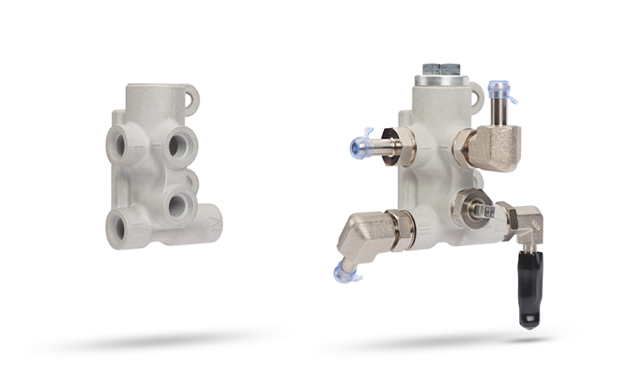In today's rapidly evolving industrial landscape, supply chain resilience is more crucial than ever. With global disruptions becoming the new norm, manufacturers and supply chain managers are continually seeking innovative solutions to enhance efficiency and reduce risks. Enter 3D additive manufacturing (AM) - a game-changing technology that promises to revolutionize supply chains worldwide. In this blog post, we'll explore how 3D additive manufacturing can enhance supply chain flexibility, reduce inventory costs and delivery cycles, and mitigate risks through localized manufacturing.
Supply chain challenges are nothing new, but recent global events have highlighted the fragility of traditional supply chains. From natural disasters to trade restrictions, disruptions can cause significant delays and financial losses. This is where 3D additive manufacturing steps in. By enabling on-demand production, localized manufacturing, and customization, 3D AM offers promising solutions to enhance supply chain resilience.
1. On-Demand Production
One of the most significant advantages of 3D additive manufacturing is its ability to facilitate on-demand production. Unlike traditional manufacturing, which requires large batches, 3D printing allows for the production of items as needed. This reduces the need for extensive warehousing and ensures that products can be made quickly to meet demand.
For instance, during the COVID-19 pandemic, many companies turned to 3D printing to produce essential medical supplies, demonstrating the technology's ability to adapt swiftly to changing needs.
2. Localized Manufacturing
Localized manufacturing is another critical benefit of 3D printing. By setting up 3D printing facilities closer to the end consumer, companies can reduce shipping costs and lead times. This not only enhances supply chain efficiency but also reduces the carbon footprint associated with long-distance transportation.
An excellent example of localized manufacturing is the automotive industry. Leading car manufacturers are increasingly using 3D printing to produce spare parts locally, ensuring quicker repairs and reducing downtime.
3. Customizable Products
In today's market, customization is king. Consumers are increasingly looking for products tailored to their specific needs and preferences. 3D additive manufacturing makes it easier than ever to offer customized solutions. Whether it's personalized medical implants or bespoke fashion items, 3D printing allows for a level of customization that traditional manufacturing struggles to achieve.
Nike, for example, has utilized 3D printing to create customized athletic shoes, offering consumers a unique and personalized product experience.
4. Faster Prototyping and Iterations
The traditional prototyping process can be time-consuming and costly. However, 3D additive manufacturing speeds up this process significantly. Companies can quickly create prototypes, test them, and make necessary adjustments, all without the long wait times associated with traditional methods.
This rapid prototyping capability is particularly beneficial in industries like aerospace and automotive, where innovation and timely product development are critical.
5. Sustainability and Waste Reduction
Sustainability is an increasingly important consideration for modern businesses. 3D additive manufacturing contributes to sustainability by reducing waste. Traditional manufacturing often involves cutting away excess material, leading to significant waste. In contrast, 3D printing builds products layer by layer, using only the material necessary for the final product.
This approach not only minimizes waste but also allows for the use of sustainable materials, further enhancing a company's environmental credentials.

Traditional supply chains often involve multiple stages, from raw material procurement to assembly and distribution. Each stage adds time and costs, leading to long lead times and substantial inventory holding costs. In contrast, 3D additive manufacturing streamlines this process, allowing for more direct and efficient production.
On-demand manufacturing through 3D printing reduces the need for large inventories. Instead of producing large quantities of products to be stored and potentially wasted, companies can produce items as needed. This just-in-time approach not only reduces warehousing costs but also minimizes the risks associated with overproduction.
Just-in-time (JIT) manufacturing is a strategy that aligns production schedules with current demand, reducing the need for extensive inventory. 3D additive manufacturing supports JIT by enabling rapid production and quick adjustments to meet market demands. This flexibility ensures that companies can respond swiftly to changes, reducing the risk of stockouts or overstock situations.
Supply chains are vulnerable to various disruptions, from natural disasters to geopolitical tensions. These events can halt production, delay shipments, and lead to financial losses. However, 3D additive manufacturing offers a solution by enabling localized production.
During crises, having the ability to produce goods locally can be a game-changer. For example, during trade restrictions, companies can use local 3D printing facilities to continue production without relying on international suppliers. This localized approach ensures continuity and reduces the impact of global disruptions.
Localized manufacturing not only mitigates risks but also offers other advantages, such as faster delivery times and reduced shipping costs. By bringing production closer to the consumer, companies can enhance customer satisfaction and build stronger, more resilient supply chains.
China is set to host its largest 3D printing and additive manufacturing event, TCT Asia 2025, at the NECC in Shanghai from March 17-19, 2025. This event will bring together industry leaders, innovators, and enthusiasts to explore the latest advancements in 3D printing technology.
TCT Asia 2025 will feature cutting-edge technologies and real-world applications of 3D additive manufacturing. Attendees can expect to see demonstrations of the latest 3D printers, materials, and software solutions, all designed to enhance supply chain resilience and efficiency.
Attending TCT Asia 2025 offers valuable insights and networking opportunities for manufacturers, supply chain managers, and technology enthusiasts. The event will provide practical takeaways and highly focused content to help attendees evaluate, adopt, and optimize their additive manufacturing requirements.
3D additive manufacturing is transforming supply chains, offering solutions to enhance flexibility, reduce costs, and mitigate risks. By adopting this innovative technology, companies can build more resilient and efficient supply chains, better prepared to handle the challenges of today's dynamic industrial landscape.
Join us at TCT Asia 2025 to explore the latest advancements in 3D printing and additive manufacturing and discover how your business can benefit from this revolutionary technology.
Learn more about TCT Asia 2025 and register for the event today!